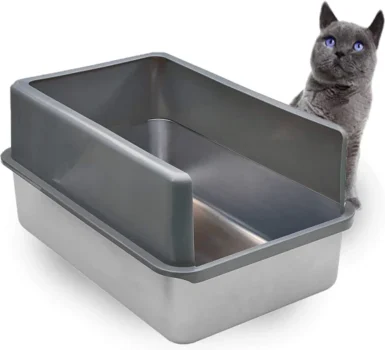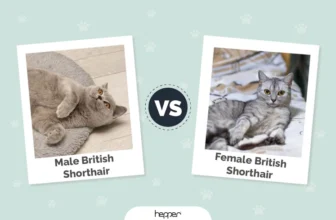Welcoming a new pet into your home can be an exciting and fulfilling experience, but it also comes with its own set of challenges. American Shorthairs are a popular breed for many households for their charming personality and independence, but like all cats, they require proper litter box training to avoid any mess and stress. Avoiding common mistakes is essential for facilitating a healthy and comfortable litter box experience for your American Shorthair. In this article, we’ll take a closer look at ten common litter box mistakes to avoid when training your feline friend. From choosing the right litter box to encouraging your cat to use it, we’ll offer step-by-step tips to ensure your cat is comfortable and their litter box area is clean and functional.
Mistake #1: Choosing the Wrong Litter Box
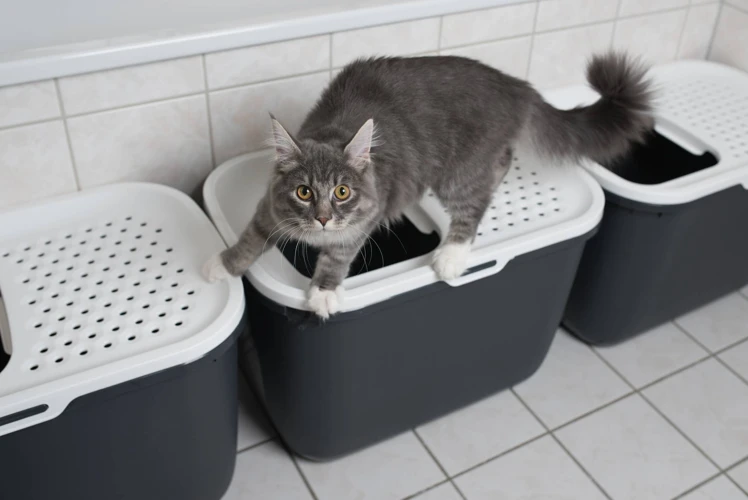
Choosing the right litter box is essential for the success of litter box training your American Shorthair. Many cat owners are unaware of the common mistakes that can lead to litter box problems and subsequently affect their cat’s behavior. Your choice of litter box can either make or break the litter box training process, which is why it is essential to select the right one. In this section, we’ll discuss some of the common mistakes that cat owners make while selecting a litter box for their American Shorthair and provide you with tips on how to avoid them to ensure successful litter box training. Keep reading to find out how you can create a comfortable environment for your cat to use the litter box. To learn more about litter box training your American Shorthair, check out our guide on Litter Box Training Your American Shorthair.
1.1 Covered Litter Box
A covered litter box can be a popular choice for many cat owners because it provides more privacy and helps to control litter scatter. While this type of litter box may seem like a good idea, it can actually be a mistake for American Shorthair cats.
One issue with covered litter boxes is that they can trap odors inside, making the litter box area smell even more unpleasant. This can be especially problematic for an American Shorthair, which has a strong sense of smell. They may avoid using the litter box altogether if it smells too strongly.
Covered litter boxes can be too small for larger cats like the American Shorthair. If the cat feels cramped or uncomfortable inside the box, they may avoid using it altogether. Choosing the right litter box size and type is important for keeping your American Shorthair comfortable and happy with their litter box.
Here is a handy table showing some pros and cons of covered litter boxes:
| Pros | Cons |
|---|---|
| Provides privacy | Can trap odors inside |
| Helps control litter scatter | May be too small for larger cats |
| May cause discomfort or anxiety for some cats |
Ultimately, the decision to use a covered litter box for your American Shorthair is up to you. However, it is important to be aware of the potential drawbacks so that you can make an informed decision about what is best for your cat. For other tips on keeping your American Shorthair’s litter box clean and comfortable, check out our article on Shorthair Litter Box Troubleshooting.
1.2 Too Small Litter Box
Having a litter box that is too small for your American Shorthair cat is a common mistake that many new cat owners make. While it may seem like a good idea to save space, a small litter box can cause discomfort and lead to litter box aversion. Cats need to be able to turn around and move about comfortably while using the litter box.
Here are some signs that your cat’s litter box might be too small:
- Your cat appears cramped or uncomfortable while using it.
- Your cat has trouble turning around while inside the litter box.
- Your cat steps out of the litter box immediately after using it, as though trying to escape.
Providing your American Shorthair cat with a litter box that is appropriately sized will help encourage litter box use and prevent accidents around the house. A good rule of thumb is to get a litter box that is at least one and a half times the length of your cat. For larger cats, you may need to opt for an extra-large litter box or even consider getting two smaller boxes.
Remember, the size of the litter box is just as important as its location and the type of litter you use. Making sure that your cat has a comfortable and clean place to do their business is essential for maintaining good litter box habits. Check out our tips for keeping your cat’s litter box clean to ensure a happy and healthy cat.
Mistake #2: Putting the Litter Box in the Wrong Place
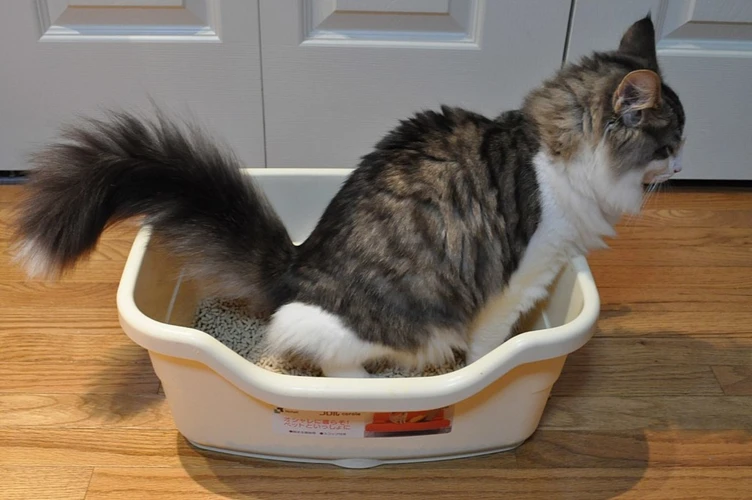
Finding the perfect spot for your American Shorthair’s litter box can be a challenging task. Placing it in the wrong location can lead to unwanted behavior, such as going outside the box or avoiding it completely. In this section, we’ll explore some common mistakes to avoid when putting your cat’s litter box in the house. By the end, you’ll know exactly where to position the box in order to encourage your American Shorthair to use it consistently. And if you’re looking for more information on litter box training, check out these litter box training tips for American Shorthair cats or kittens.
2.1 Noisy or Busy Area
Cats are sensitive creatures, and they prefer to do their business in a quiet, private space. Placing the litter box in a noisy or busy area can be a major mistake when trying to train an American Shorthair. Loud sounds and sudden movements can startle your cat and make them reluctant to use the litter box. Additionally, a busy area may be too distracting for your cat to fully relax and use the litter box as intended.
Here are some tips for finding a quiet area for your cat’s litter box:
- Choose a room in your home that is less frequently used
- Select an area that is away from appliances or equipment that make loud noises
- Avoid placing the litter box near doors or windows where outside noises can be heard
- Consider using an enclosed litter box to help muffle any outside noises
By providing a quiet and private space for your American Shorthair’s litter box, you can help them feel comfortable and relaxed while doing their business. This can ultimately lead to a more successful litter box training experience.
2.2 Isolated Area
Having the litter box in an isolated area may seem like a good solution, but it can actually be a problematic mistake when training your American Shorthair. Cats are social animals, and they don’t like to feel cut off from their family. Placing the litter box in an isolated area of your home may cause your cat to feel lonely and isolated, leading them to avoid using the litter box altogether.
Instead, position the litter box in a moderately busy area of your home where your cat can have some privacy but also feel connected to their family. This can help ensure that your cat will not resist using the litter box, which will save you from having to clean up any accidents.
To make the litter box area feel more connected to the rest of your home, consider placing some toys or a scratching post nearby. This will make the area more appealing for your cat and encourage them to use the litter box regularly.
Additionally, it’s important to make sure that the litter box is positioned in a safe and accessible area. If your cat has to climb stairs or navigate through narrow spaces to reach the litter box, they may be less likely to use it consistently. Consider placing one litter box on each floor of your house to make sure that your cat always has easy access to a litter box when they need it.
Remember, cats are creatures of habit, and they rely on consistency and routine. By selecting the right location for your cat’s litter box, you can help them develop good habits and avoid any unpleasant accidents.
Mistake #3: Not Enough Litter Boxes

One of the most common mistakes cat owners make when litter box training their American Shorthair is not providing enough litter boxes. This can lead to a variety of issues, including inappropriate elimination and even behavioral problems. As a conscientious pet owner, it’s important to understand the importance of having multiple litter boxes in different parts of your home. In this section, we’ll discuss the problems that can arise from not having enough litter boxes and how you can avoid them. So, let’s dive in and explore this crucial topic in more detail.
3.1 Not Enough Boxes for the Number of Cats
For cat owners, the number of litter boxes is an essential factor to consider. One common mistake is having not enough boxes for the number of cats in the household. It’s essential to have at least one litter box per cat, plus one extra. For instance, if you have two cats, you’ll need three litter boxes.
- Having too few litter boxes may result in kitties avoiding using the litter box, which leads to soiling in inappropriate places.
- Some cats prefer to have separate boxes, especially if the cats are not friendly with each other. Fights over the box may result in a cat avoiding the litter box altogether.
- Having only one litter box scattered across the house increases the likelihood of your cat not using it. This is especially true if the box is not located in a convenient area for your cat to access easily.
Cats are territorial animals and having their own designated litter box provides them with a sense of ownership. It’s essential to ensure that litter boxes are appropriately spaced out to cater to the cats’ needs. If your home is large, consider putting litter boxes in different parts of the house to make it easier for all cats to access one. By doing this, you decrease the chances of any cat being territorial over the shared litter box. Remember, having more litter boxes provides your cat with options and helps prevent litter box issues!
3.2 Not Enough Boxes in Different Parts of the House
One of the most common mistakes that cat owners make when it comes to litter boxes is not having enough litter boxes in different parts of their house. This can be especially problematic in larger homes where your American Shorthair may not be able to make it to the litter box in time.
To avoid this issue and ensure that your cat has easy access to a litter box, it’s important to have multiple litter boxes spread throughout your home. This will not only ensure that your cat always has a convenient and accessible place to do their business, but also reduce the odds of them choosing another, less desirable spot.
But how many litter boxes should you have? Generally, the rule of thumb is to have one more litter box than the number of cats you have. So, if you have one cat, you should ideally have two boxes, and so on.
But it’s not just about having more boxes, it’s also important to place them strategically. Consider having a litter box on each level of your home, so your cat doesn’t have to go too far to find one. If you notice your cat spending a lot of time in a particular room, it may also be a good idea to place a litter box nearby.
To make it easy to keep track of your litter boxes, consider creating a litter box log. This can help you keep track of when each box was last cleaned and identify when it’s time to replace the litter or the box itself.
Here’s a table to summarize the key points:
| Key Points |
|---|
| Have one more litter box than the number of cats you have |
| Place litter boxes strategically throughout your home, consider having one on each level |
| Create a litter box log to stay organized and on top of cleaning and maintenance |
By taking the time to strategically place litter boxes throughout your home, you can avoid the mistake of not having enough litter boxes and ensure that your American Shorthair has a safe and accessible place to do their business.
Mistake #4: Not Scooping Often Enough
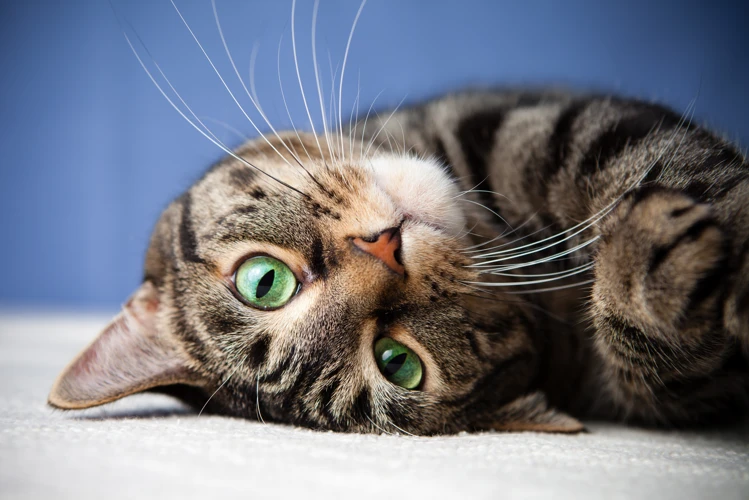
One of the most important tasks of being a cat owner is maintaining a clean litter box. Neglecting this responsibility can lead to unpleasant odors, unsanitary conditions, and even health problems for your American Shorthair. However, some owners fail to scoop often enough, potentially leading to dire consequences. In this section, we’ll discuss the consequences of neglecting to scoop often enough and provide advice on how to maintain a clean litter box.
4.1 How Often to Scoop
The frequency at which you scoop your American Shorthair’s litter box is crucial to their overall health and comfort. Let’s take a look at how often you should be scooping the litter box in order to avoid any unpleasant mishaps.
| Frequency | Description |
|———–|————-|
| Once a Day | At a minimum, you should scoop your cat’s litter box once a day. This ensures that any waste is removed quickly, preventing unpleasant smells and bacteria from accumulating.|
| Twice a Day | Ideally, you should aim to scoop the litter box twice a day, especially if you have more than one cat. This reduces the likelihood of litter box rejection, as well as urinary tract infections, which can be painful and even life-threatening for your American Shorthair.|
| After Every Use | Depending on your cat’s habits, you may need to scoop the litter box after every use. This is particularly important for kittens who are still getting the hang of using the litter box. Keeping the litter box clean will help them learn faster and prevent ‘accidents’ around the house.|
It’s important to note that this is a general guideline and the frequency might vary depending on your cat’s specific needs. By keeping their litter box clean, you’re ensuring their comfort and overall well-being.
4.2 What to Do with Used Litter
When it comes to disposing of used litter, there are a few important considerations to keep in mind to ensure a hygienic and odor-free environment for both you and your furry friend. Here are some tips on what to do with used litter:
| Option | Details |
|---|---|
| Dispose in a Plastic Bag | Used litter can be placed in a plastic bag and tied tightly to seal in odors. Be sure to dispose of the bag in an outdoor trash can. Avoid leaving used litter in an indoor trash can for any length of time, as it can quickly begin to smell and attract pests. |
| Use Clumping Litter | If you use clumping litter, you can easily scoop out clumps and place them in a plastic bag for disposal. This will help minimize the amount of unused litter that needs to be thrown away, as well as make cleanup easier. |
| Compost | If you have a compost pile or bin, you can dispose of used litter in it. This is an eco-friendly option that helps reduce waste. However, it’s important to note that cat feces should not be composted if you plan to use the compost on edible plants, as it can contain harmful bacteria. |
| Flushable Litter | There are some litters on the market that can be safely flushed down the toilet. However, it’s important to check with your local municipality to see if this is allowed in your area. Some areas prohibit flushing cat litter due to concerns about bacteria and chemicals contaminating water supplies. |
Remember, proper disposal of used litter is an essential part of maintaining a clean and healthy litter box. Failure to do so can lead to unpleasant odors, unsanitary conditions, and even health risks for you and your cat.
Mistake #5: Using the Wrong Litter
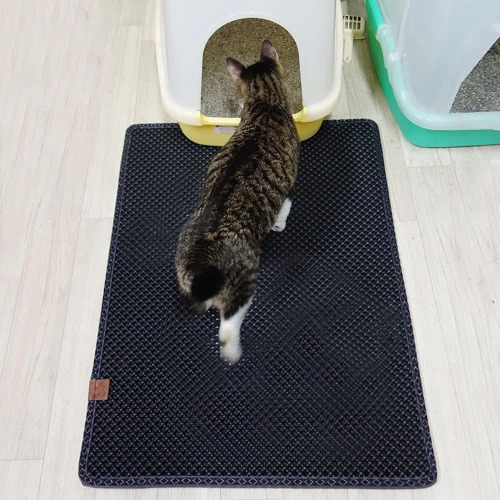
Choosing the right type of litter for your American Shorthair cat is crucial for their overall health and comfort. However, using the wrong type of litter is a common mistake many cat owners make. It’s important to remember that not all litter is created equal, and picking the wrong one can cause your feline friend to avoid the litter box altogether. In this section, we’ll delve into the two most critical factors to consider when choosing the right litter for your cat: avoiding strong-smelling litter and choosing the right texture. Let’s explore this topic in detail.
5.1 Avoiding Strong-Smelling Litter
When choosing the right litter for your American Shorthair, it’s important to keep in mind that strong-smelling litter may not be the best option. While you may think that a strong scent will mask any unpleasant odors, it could actually be overwhelming for your cat and deter them from using the litter box altogether.
Instead, opt for unscented or lightly scented litter that won’t be off-putting to your feline friend. Unscented litter is the safest choice, as it won’t contain any potentially harmful chemicals or irritants that could harm your cat’s respiratory system.
Take a look at this comparison table for some of the best litter options:
| Litter Brand | Type | Scented or Unscented | Price |
|---|---|---|---|
| Dr. Elsey’s Ultra | Clumping | Unscented | $$ |
| World’s Best Cat Litter | Clumping | Lightly Scented or Unscented | $$$ |
| Arm & Hammer Clump & Seal | Clumping | Lightly Scented | $ |
Keep in mind that while unscented litter may be the safest and most cat-friendly option, it may not completely eliminate odors. You may want to supplement with other odor-eliminating products, such as litter box deodorizers or air purifiers, to keep your home smelling fresh.
By avoiding strong-smelling litter and choosing a gentle, unscented option, you’ll be creating a comfortable and inviting litter box environment for your American Shorthair.
5.2 Choosing the Right Texture
When it comes to choosing the right texture for your American Shorthair’s litter box, the decision may not be as straightforward as you think. Some cats prefer certain textures over others, and choosing the wrong one could lead to your cat avoiding the litter box altogether.
Clumping versus non-clumping: One of the main choices you’ll need to make is between clumping and non-clumping litter. Clumping litter is easier to clean, as it forms solid clumps around urine and feces that can be scooped out entirely. Non-clumping litter is less expensive, but will require a full litter change more frequently.
Crystals: Crystal litter is another option, made from silica gel that can absorb large amounts of urine. It is also less likely to stick to your cat’s paws and get tracked around the house. However, some cats may find the texture uncomfortable and may avoid the litter box entirely.
Paper: Paper litter is also available, and is composed of recycled newspaper or other paper products. It is dust-free and biodegradable, making it an eco-friendly option. However, some cats may be deterred by the texture and its inability to clump.
Corn, wheat, and other natural materials: Litter made from corn, wheat, and other natural materials has increased in popularity in recent years due to its biodegradability and eco-friendliness. However, some cats may be sensitive to the texture, and these litters may produce more dust than other options.
Consider trying out different textures to see which one your cat prefers. It may take some trial and error, but finding the right texture can make all the difference in your American Shorthair’s litter box habits.
| Type of Litter | Pros | Cons |
|---|---|---|
| Clumping | Easily scoopable, less frequently changed | More expensive, may produce dust and strong odors |
| Non-clumping | Less expensive, easily disposed of | Needs full litter change more frequently, may produce more dust |
| Crystals | Absorbs large amounts of urine, less likely to stick to paws | May produce strong odors, cats may not like texture |
| Paper | Biodegradable, dust-free | May not clump, cats may not like texture |
| Natural materials (corn, wheat, etc.) | Biodegradable, eco-friendly | May produce more dust, cats may be sensitive to texture |
Mistake #6: Cleaning Litter Box Incorrectly
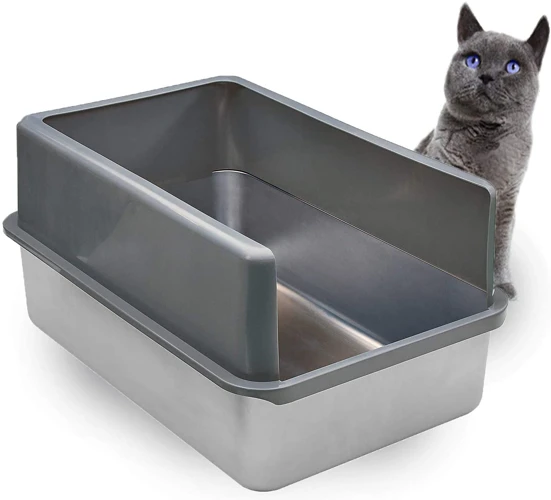
Keeping the litter box clean is essential for a happy, healthy, and odor-free home. Unfortunately, many cat owners make the mistake of cleaning the litter box incorrectly, which can lead to a host of problems. Neglecting to clean your cat’s litter box properly can create an uninviting or unsanitary bathroom experience for your feline friend and result in your cat avoiding the litter box altogether. In this section, we will explore some of the most common cleaning mistakes cat owners make and provide tips to avoid them. Let’s dive in and uncover the best practices for keeping your cat’s litter box clean and fresh.
6.1 Using Harsh Cleaners
Keeping your American Shorthair’s litter box clean is crucial for their health and happiness. However, using harsh cleaners can actually do more harm than good. Many cleaning products contain toxic chemicals that can cause respiratory issues for your cat. It’s important to choose a cleaner that is safe for your feline friend.
To make things easier for you, we’ve compiled a list of cleaning products that are safe for your American Shorthair and their litter box. Here is a table of recommended cleaners:
| Product Name | Description | Price |
|---|---|---|
| Nature’s Miracle Just for Cats Litter Box Cleaner | A natural, enzymatic cleaner that helps remove tough stains and odors. | $5.99 |
| Pet Safe Non-Toxic Litter Box Cleaner | A non-toxic formula that works to break down tough stains and odor-causing bacteria. | $9.99 |
| Arm & Hammer Simply Saline Litter Box Deodorizer | A saline spray that helps neutralize odors without the use of harsh chemicals. | $3.49 |
In addition to using safe cleaning products, it’s important to clean the litter box regularly. Aim to scoop out waste at least once a day and do a full clean of the litter box once a week. By keeping the litter box clean and using safe cleaning products, your American Shorthair will be much happier and healthier.
6.2 Tips for Proper Cleaning
To properly clean your American Shorthair’s litter box, there are several key tips to keep in mind. Follow the tips below to ensure that your cat’s litter box is clean, safe, and comfortable at all times.
| Tips for Proper Cleaning |
|---|
|
1. Wear gloves and a mask while cleaning When cleaning your cat’s litter box, it’s important to protect yourself from any potential bacteria or viruses that could be lurking in the litter or feces. Wear gloves and a mask to avoid breathing in any harmful particles and to protect your hands from coming into contact with waste. |
|
2. Use mild, unscented cleaners Avoid using harsh cleaners or bleach to clean your cat’s litter box, as this can irritate your cat’s sensitive nose and skin. Instead, use mild, unscented cleaners and warm water to thoroughly clean the box. Some good options include a mixture of white vinegar and water, or mild dish soap and warm water. |
|
3. Scrub thoroughly with a brush Use a sturdy brush, such as a scrub brush or toilet brush, to thoroughly scrub the inside of the litter box. Pay extra attention to the corners and crevices, where bacteria and odor can build up over time. |
|
4. Rinse well with warm water After scrubbing the litter box, rinse it well with warm water to remove any remaining soap or debris. Make sure to rinse the box thoroughly, as any leftover soap or cleaning solution can irritate your cat’s skin and eyes. |
|
5. Dry completely before refilling with litter After cleaning and rinsing the litter box, be sure to let it dry completely before adding fresh litter. Any moisture left in the box can cause the litter to clump or stick, making it more difficult for your cat to use the box. |
Remember, proper cleaning is essential to maintaining your American Shorthair’s litter box and ensuring that your cat is comfortable and healthy. By following the tips above, you can keep your cat’s litter box clean and fresh-smelling, promoting optimal litter box usage and overall feline health.
Mistake #7: Not Enough Privacy

As social creatures, cats sometimes crave privacy just like humans do. In fact, lack of privacy is one of the most common reasons why cats may avoid using their litter boxes. It’s important to create an environment that feels safe and secure for your American Shorthair, which includes providing adequate privacy options. Let’s take a closer look at some of the common privacy mistakes cat owners make and how to avoid them.
7.1 Choosing the Right Litter Box Cover
When it comes to providing your American Shorthair with enough privacy, choosing the right litter box cover is important. Not all cats enjoy covered litter boxes, but if your cat does, then it’s important to choose the right cover for them to feel comfortable. Here are some factors to consider when choosing the right litter box cover:
| Factor | Importance |
|---|---|
| Size | Choosing the right size cover is crucial to ensure your cat can comfortably move around inside the litter box and have enough space to do their business. |
| Material | The material of the litter box cover can affect the smell and cleanliness of the litter box. Look for covers made of materials that are easy to clean and won’t trap odors. |
| Openings | The number and placement of openings in the litter box cover should be considered. Too many openings or openings placed in the wrong areas can compromise the privacy of the cat. |
| Color | The color of the litter box cover is mainly a matter of personal preference, but choosing a color that blends in with your home decor can make the litter box less intrusive. |
Ultimately, choosing the right litter box cover is important to ensure your cat has a comfortable and private place to do their business. Take into consideration the size, material, openings, and color of the cover to find the perfect fit for your American Shorthair.
7.2 Privacy-Enhancing Tips
Creating a private litter box area for your American Shorthair can help reduce stress and make them feel more comfortable during their bathroom routine. Here are some tips to enhance privacy:
| Tip | Description |
|---|---|
| Use a covered litter box | A covered litter box can provide your cat with a sense of privacy and security while they do their business. Just make sure to choose a box that is large enough for your cat and allow for adequate ventilation. |
| Place the litter box in a quiet area | Choose a quiet and low-traffic area of your home for the litter box, away from appliances, TVs or frequent foot traffic. This will provide your cat with a peaceful environment to use the litter box. |
| Add a litter box liner | Adding a liner to the litter box can provide an extra level of comfort and privacy for your cat. It can also make cleaning a breeze! Just make sure to choose a high-quality liner that won’t tear or break. |
| Use a litter box with high sides | A litter box with high sides can help provide your cat with a sense of privacy and prevents litter from being kicked out of the box. This type of litter box can also work well for a cat that is prone to spraying. |
| Place the litter box in a corner | Positioning the litter box in a corner can create a cozy and secure environment for your cat. It also helps to minimize the amount of litter that gets spread around your home. |
By implementing these privacy-enhancing tips, you can provide your American Shorthair with a comfortable and secure space to use the litter box. Remember that each cat’s preferences may vary, so observe your cat’s behavior and adjust accordingly.
Mistake #8: Cat Not Comfortable with Litter Box
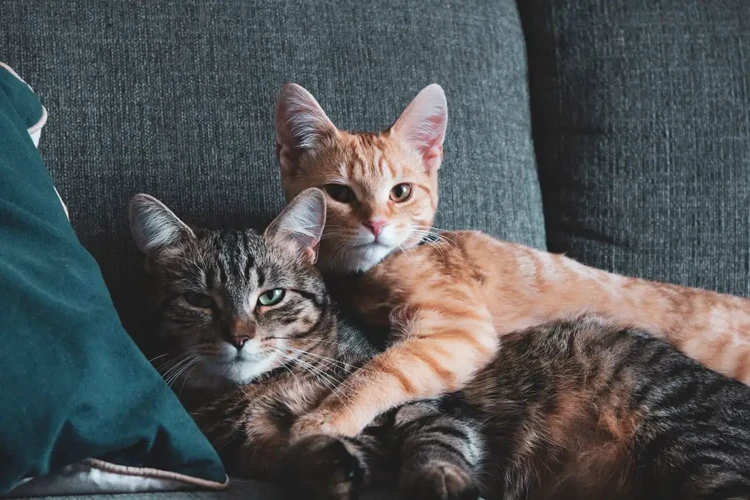
One of the essential factors in successfully litter box training your American Shorthair is ensuring that your feline is comfortable with using the litter box. However, some cat owners overlook this crucial element, which can lead to negative behaviors such as urinating or defecating outside the box. Understanding the reasons why your cat might be uncomfortable with the litter box and how to address these issues can help make the litter box a more welcoming and inviting place for your furry friend. Let’s explore some common culprits behind this mistake and learn how to fix them.
8.1 Encouraging Your Cat to Use the Litter Box
Encouraging your cat to use the litter box is an essential part of successful litter training. While some cats take to the litter box naturally, others may need extra encouragement. Here are some tips for helping your American Shorthair get comfortable with their litter box:
1. Show them the litter box: When you first bring your cat home, show them where the litter box is located. Place them in the box so they can sniff around and get familiar with it. The more comfortable they are with their surroundings, the more comfortable they’ll be using their litter box.
2. Use a litter they prefer: Many cats have a preferred litter type, so it’s important to find one that your American Shorthair is comfortable using. Experiment with different textures, such as clumping or non-clumping litter. You can also try different scented or unscented varieties to see what they prefer.
3. Keep litter box clean: Make sure you keep the litter box clean and scoop it regularly. This will ensure that your American Shorthair is not discouraged from using the box due to an unpleasant smell or dirty conditions.
4. Make it accessible: Make sure your American Shorthair can easily access their litter box. If they have to climb over obstacles, they may be less likely to use it. Additionally, if you have a multi-level home, make sure there is a litter box on each level.
5. Offer praise and rewards: Positive reinforcement can go a long way in encouraging your American Shorthair to use their litter box. Offer vocal praise when they use the box, and follow up with a treat or toy.
Here is an overview of these tips in an HTML table:
| Tips for Encouraging Your Cat to Use the Litter Box |
|---|
| 1. Show them the litter box |
| 2. Use a litter they prefer |
| 3. Keep litter box clean |
| 4. Make it accessible |
| 5. Offer praise and rewards |
Remember, each cat is unique and may require different approaches when it comes to litter training. Be patient and consistent in your efforts, and with time, your American Shorthair will become more comfortable using their litter box.
8.2 Addressing Fear or Anxiety
Cats may sometimes experience fear or anxiety when it comes to using their litter box. This can lead to a variety of litter box problems, including refusal to use the box altogether. It’s essential to take steps to address any fear or anxiety your American Shorthair may have related to their litter box.
There are several reasons why a cat may feel afraid or anxious about using their litter box. Some possible causes include previous negative experiences, illness or pain, or changes to their environment or routine. Here are some ways you can help alleviate your cat’s fear or anxiety related to their litter box:
| 1. Create a Calming Environment: | Make sure the litter box is placed in a quiet, low-traffic area of your home. Consider adding calming elements, such as a pheromone diffuser or soothing music, to help your cat feel more relaxed. |
| 2. Address Pain or Illness: | If your cat is experiencing pain or illness, it’s essential to address these issues as soon as possible. Speak with your veterinarian, who may recommend pain management or other treatments to help your cat feel more comfortable. |
| 3. Use Positive Reinforcement: | Reward your cat with treats and praise when they use the litter box correctly to help create positive associations. Avoid punishing your cat for accidents, as this can cause further anxiety or fear. |
| 4. Consider Different Litter Box Options: | If your cat is still experiencing fear or anxiety despite your efforts, consider trying a different litter box type, such as an open box or one with a lower entrance. This may help your cat feel more comfortable and confident. |
It’s important to be patient and consistent when working to address your cat’s fear or anxiety related to their litter box. If your cat is still struggling, consider speaking with your veterinarian or a cat behaviorist for additional guidance and support.
Mistake #9: Not Enough Hygiene

Maintaining proper hygiene of your American Shorthair’s litter box is not just about keeping your house clean and free from unpleasant odors. It is crucial for your cat’s health and well-being. Without regular and thorough cleaning, bacteria and parasites can thrive in the litter box and make your feline friend sick. In this section, we will discuss the importance of hygiene and the common mistakes that cat owners make when it comes to maintaining a clean litter box. Let’s dive in and explore some simple but effective hygiene practices that can contribute to your cat’s overall health and happiness.
9.1 Proper Grooming Practices
Maintaining good hygiene is essential when it comes to litter box training for American Shorthairs. Proper grooming practices can go a long way in keeping your cat healthy and happy. Here are some essential grooming practices that every cat owner should follow:
| Grooming Practice | Description |
|---|---|
| Groom Your Cat’s Fur Regularly | American Shorthair cats require regular grooming to keep their coats looking healthy and shiny. Brushing your cat’s fur daily removes loose hair, dirt, and debris, which can contribute to litter box odors. It also helps distribute their natural oils, which moisturize their skin and prevent dryness and irritation. |
| Trim Your Cat’s Nails | Trimming your cat’s nails frequently is a crucial step in maintaining litter box hygiene. Long nails can become dirty and trap fecal matter, causing discomfort and infection. They can also scratch and damage the litter box, making it an unpleasant place for your cat. Use cat-specific nail clippers to trim your cat’s nails every two to four weeks. |
| Clean Your Cat’s Ears | Dirty ears can cause discomfort and even lead to infections. Clean your cat’s ears once a week using a damp cotton ball or a specially formulated ear cleaner. Gently wipe away any dirt or debris visible on the surface of the ear. Avoid using cotton swabs, as they can push debris further into the ear canal and cause damage. |
| Brush Your Cat’s Teeth | Oral hygiene is just as important for cats as it is for humans. Regular teeth-brushing can prevent a wide range of dental issues, including bad breath, gum disease, and tooth decay. Purchase a soft-bristled toothbrush and toothpaste specially designed for cats, and brush your cat’s teeth every other day. Start slow and gently, eventually working up to longer brushing sessions. |
By following these proper grooming practices, you can help keep your American Shorthair cat healthy and comfortable and create a more pleasant litter box experience for both you and your feline friend.
9.2 Monitoring for Signs of Infection or Disease
It’s crucial to monitor your American Shorthair for signs of infection or disease, especially when it comes to their litter box habits. Here are some signs you should look out for:
| Signs of Infection or Disease | What to Do |
|---|---|
| Increased or decreased urination | Contact your veterinarian immediately as this could be a sign of a urinary tract infection or blockage. |
| Blood in urine or feces | Again, contact your veterinarian immediately. This could be a sign of a serious health issue. |
| Unusual odor in litter box | This could be due to a variety of issues, including infections or diabetes. Contact your veterinarian to rule out any health issues. |
| Changes in litter box habits | If your American Shorthair suddenly starts avoiding the litter box or seems to be straining to go, it could be a sign of an underlying health issue. Contact your veterinarian to have them examined immediately. |
It’s essential to take any changes in your cat’s litter box habits seriously and consult with a veterinarian if you notice anything concerning. By addressing any potential health issues right away and taking the necessary steps to keep your American Shorthair healthy, you’ll help ensure that they continue to use their litter box consistently.
Mistake #10: Neglecting To Replace Litter Box
As a responsible cat owner, it’s important to ensure that your American Shorthair has a clean and comfortable litter box to use. One common mistake that many cat owners make is neglecting to replace the litter box when it becomes too worn out or dirty. This oversight can lead to a variety of issues, including your cat avoiding the box altogether or even developing health problems. In this section, we’ll explore the importance of replacing your cat’s litter box and offer some tips on how to choose a suitable replacement. So, let’s dive in and discover why neglecting to replace your cat’s litter box is a mistake you won’t want to make!
10.1 When to Replace the Litter Box
As a responsible pet owner, it’s important to know when to replace your American Shorthair’s litter box. Over time, litter boxes can accumulate scratches and cracks that harbor bacteria and make cleaning difficult. Additionally, your cat’s claws can get caught in these imperfections, causing discomfort and avoiding the litter box. Thus, it is imperative to replace the litter box every so often.
So, when exactly should you replace the litter box?
There isn’t a set timeline for when to replace your cat’s litter box. However, the Humane Society recommends replacing the litter box at least once a year. If your American Shorthair has an existing medical condition, cleaning the litter box more frequently can help keep them healthy. Similarly, if you notice that your cat avoids the litter box or has accidents outside of it, it’s time to consider replacing the litter box.
When the time comes to replace the litter box, you may want to look into different options available. There are various litter boxes available on the market, each with their own features and benefits. For instance, you might consider getting a self-cleaning litter box that can tackle odor and waste removal, saving you time and effort. Alternatively, you might consider a litter box with a top entrance, which can provide your cat with additional privacy.
Here’s a table outlining some common signs that it’s time to get a new litter box:
| Signs It’s Time for a New Litter Box | Possible Reasons |
|---|---|
| Cracks, scratches, or stains are visible on the litter box | Bacteria might be thriving in the box, or it’s too difficult to clean |
| Your cat avoids the litter box or starts going outside of it | The box isn’t comfortable or clean enough for them |
| The litter box has an odor that can’t be masked with Deodorizers or regular cleaning | The box might not be able to handle the amount of waste or it’s not being cleaned frequently enough |
| The litter box has scratches or cracks | Your cat’s claws may get stuck and cause Painless injuries or avoid using the box |
Replacing the litter box at least once a year is recommended to prevent bacterial buildup and discomfort for your American Shorthair cat. Look for signs that indicate that it’s time to replace the litter box, such as cracks, stains, and odor, and consider getting a new litter box with different features and benefits.
10.2 Different Litter Box Options
When it’s time to replace your litter box, you have a variety of options to choose from. Here are some of the most popular types of litter boxes on the market:
- Top-Entry Litter Box: This type of litter box is ideal for cats who like privacy and tend to kick litter out of the box. The entrance is located on the top of the box, which keeps litter from getting kicked out and also prevents other pets from accessing the litter box.
- Self-Cleaning Litter Box: These litter boxes use sensors to detect when a cat has used the litter box, and then automatically scoop the waste into a separate compartment. There is no need to scoop the litter on a daily basis, making it ideal for busy cat owners who don’t have a lot of time for litter box maintenance.
- Open Litter Box: Open litter boxes are the most basic and traditional type of litter box. They are open on top, making it easy for cats to access the litter and for owners to scoop and clean. However, this also means that litter can get kicked out of the box and odors can be more easily detected.
- Corner Litter Box: If space is limited, a corner litter box can be a great option. These litter boxes are designed to fit in the corner of a room, creating more space in the rest of the room. They come in a variety of shapes and sizes to fit different spaces and cats.
- Enclosed Litter Box: Enclosed litter boxes are covered, which provides cats with more privacy and prevents litter from getting kicked out. However, enclosed litter boxes can also trap odors inside, so it’s important to choose a litter with a low odor.
Consider your cat’s preferences and your own lifestyle when choosing a litter box. Some cats may prefer an open litter box, while others require more privacy. Some owners may benefit from a self-cleaning litter box, while others may prefer a basic open litter box that requires daily scooping. Regardless of which litter box you choose, make sure it’s cleaned regularly and provides enough space for your cat to move around comfortably.
Conclusion
As we wrap up our discussion on common litter box mistakes to avoid when training your American Shorthair, it’s important to remember that each cat is unique and may have individual preferences. However, by making informed choices when it comes to the litter box, you can ensure your furry friend has a comfortable and stress-free experience using it. Let’s recap some of the key takeaways from this article and explore ways to implement them in your home.
Final Thoughts
After reading through these 10 common litter box mistakes to avoid when training your American Shorthair, you should now have a clearer understanding of how to create a positive and comfortable experience for your furry friend during their visits to the litter box. Remember to choose the right litter box and place it in an appropriate location, provide enough boxes for the number of cats in your household, and scoop often enough to maintain hygiene and cleanliness. Additionally, make sure you are using the right type of litter and properly sanitizing the box to prevent unpleasant odors and discomfort for your cat. It’s also important to remember that cats appreciate privacy and may need encouragement or addressing any fear or anxiety they may have about using the litter box.
Finally, it’s crucial to maintain proper hygiene and monitor for signs of infection or disease. If you notice any changes in your cat’s behavior or physical condition, it’s always best to consult with a veterinarian to ensure their overall health and wellbeing.
By following these tips and avoiding these common litter box mistakes, you can create a positive and comfortable experience for your American Shorthair and help prevent any issues with their litter box habits. Remember, a happy and healthy cat means a happy and healthy household!
Frequently Asked Questions
What is the best type of litter box for an American Shorthair?
The best type of litter box for an American Shorthair is an uncovered, large litter box with low sides and a smooth texture.
How many litter boxes should I have for one American Shorthair?
You should have at least one litter box for each American Shorthair in your household, plus one extra box to prevent litter box stress and accidents.
How often should I scoop the litter box?
You should scoop the litter box at least once a day, or more often if you have multiple cats using the same box. This helps to maintain good hygiene and reduce odor.
What is the best litter for an American Shorthair?
The best litter for an American Shorthair is unscented, clumping litter with a fine texture. This makes it easier for your cat to dig and cover their waste.
Can I use scented litter for my American Shorthair?
It’s best to avoid using scented litter for your American Shorthair, as the strong scent can be overwhelming and unpleasant for your cat, leading to litter box aversion.
How do I keep the litter box area clean?
You can keep the litter box area clean by wiping up any stray litter or messes around the box, regularly cleaning the box itself, and using a litter mat to catch loose litter.
How can I encourage my American Shorthair to use the litter box?
You can encourage your American Shorthair to use the litter box by placing the box in a quiet, private area, keeping it clean and well-maintained, and using positive reinforcement when your cat uses the box.
What can I do if my American Shorthair is afraid of the litter box?
If your American Shorthair is afraid of the litter box, you can try introducing a different type of litter box, using positive reinforcement to encourage their use, and addressing any underlying anxiety or fear issues.
How often should I replace the litter box?
You should replace the litter box at least once a year, or more often if it shows signs of wear and tear or becomes difficult to clean. It’s also a good idea to replace the box if your cat develops litter box aversion.
What should I do if my American Shorthair stops using the litter box?
If your American Shorthair stops using the litter box, you should first check that the box is clean and well-maintained. If necessary, try changing the litter, moving the box to a different location, or seeking veterinary advice to rule out any underlying health issues.

